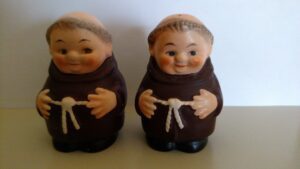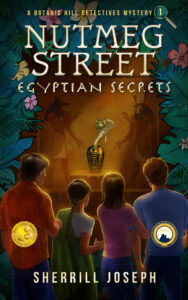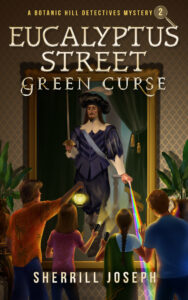Sherrill Joseph's Blog, page 13
April 15, 2021
The Isolato
Hello, Kids and All Readers,
I was a shy kid. Still am–including the kid part. How about you?
My mother used to say to me, “Sherrill, get your nose out of that book and go outside and play.” Some kids would welcome hearing an adult say that to them! I dreaded it. My calling was to be curled up reading my mystery du jour (kids, that means “of the day”). e.g., Nancy Drew. Still, I went out and played–which was a good thing for my socialization and physical development–but my mind usually remained transfixed on my book’s plot or characters awaiting me on my nightstand as my friends and I played “Moonlight, Starlight. Who’s Going to Find That Witch Tonight?” or similar games.
The pandemic and my new career as a writer have caused me to focus on a topic that has always intrigued me: The isolation and resulting angst of the artist. Or, as it is called in Italy, isolato. So, imagine my joy when in the mail the other day arrived the Spring 2021 issue of The Phi Kappa Phi Forum. The entire issue focuses on Solitude.
One article especially resonated: “Isolato,” by W.D. Wetherell (pages 18-20). He has authored over twenty books and in the article, discusses how he knows a thing or two about isolation. He has, in his words, “overdosed on it” throughout his life. Why? Because Wetherell thinks solitude, or isolation, is essential for serious artists if they are to carve out that space and time where they can develop their craft. As he puts it, “Writers need unadulterated quiet–no interruptions or social obligations to interfere in their work.” He explains that loneliness, aloneness, or alienation have characterized many first-rate American authors like Poe, Hawthorne, Thoreau, Dickinson, and J.D. Salinger. They didn’t voluntarily join the “Loneliness Club”; rather, solitude “comes with the territory” for serious artists.
Perhaps because of the pandemic and despite every author’s wish to be labeled “first-rate,” Wetherell and I agree that isolation is not trendy. It has come to be seen as a bad thing. But, he and I further agree the isolato–being in “the quiet zone”–can help us get in touch with the lonely, stricken, and oppressed of the world. How? We give ourselves the requisite time and space to have empathy for others like ourselves as we artists are chained to our writing desks, easels, musical instruments, or dance studios! The isolato is just what life has forced upon us.
So, get a clue, readers. Do you seek the voices of the lonely, either by choice or by default? For me, it happens at my desk where, ironically, I suddenly shift from being a hermit. I’m off in great company with my characters, delving into their hearts and lives, in order to deliver them and myself to the world.
April 8, 2021
Spring Has Sprung
Dear Kids and All Readers,
Here in San Diego, spring has arrived. I know. Some say it never left. But being a native San Diegan, I can definitely detect the waxing and waning of each season. I hope spring’s beautiful warmth and radiant blossoms now surround you as well.
For today, I would like to offer you two literary works to celebrate this glorious season:
 From “The Poppies” (1993)
From “The Poppies” (1993)
By Mary Oliver (American poet, 1935-2019)
The poppies send up their
orange flares; swaying
in the wind, their congregations
are a levitation
of bright dust, or thin
and lacy leaves. . . .
 From Atalanta in Calydon (1865)
From Atalanta in Calydon (1865)
By Algernon Charles Swinburne (English poet, 1837-1909)
For winter’s rains and ruins are over,
And all the season of snows and sins;
The days dividing lover and lover,
The light that loses, the night that wins;
And time remembered is grief forgotten,
And frosts are slain and flowers begotten,
And in green underwood and cover
Blossom by blossom the spring begins.
So, get a clue, Readers. I hope you’ll take some time to watch spring’s beauty unfold around you. May it and perhaps some poetry inspire you to new heights. Happy spring!
April 1, 2021
Get Ready to Strike Gold!
Dear Kids and All Readers,
You’ve been waiting for it, and here it comes! Walnut Street: Phantom Rider, Book 3 in my Botanic Hill Detectives Mysteries series, will release on November 9, 2021. Hurray!
Here’s a teaser:
Objects of value have been disappearing from the Mayfield family’s rural California horse ranch and youth saddle club for kids with emotional issues. The Mayfields invite our four intrepid detectives to their in-town house on Walnut Street to fill them in.
Adding to the excitement is that somewhere on the forty-acre ranch just outside the mountain town of Cody is a long-lost gold mine staked by thirteen-year-old Ben Mayfield’s five-time great-grandfather, Pappy Mayfield, in 1875. Pappy was one of California’s first black deputy United States marshals turned gold miner.
In private, a nervous Ben reveals a frightening secret to the detectives. At the ranch, he alone has seem a threatening black-clad figure on horseback whom he calls the Phantom Rider. Who is this mysterious person? Is he responsible for the ranch thefts? Why are objects disappearing? Is he somehow connected with the lost gold mine? The detectives aim to find out.
And here’s the placeholder cover from my website, but the real cover will be revealed in September.
So, get a clue, Readers. Saddle up and stay tuned for Book 3. You’ll strike gold with this one. Yee-haw!
March 25, 2021
“Fryer” Tucks
Hello, Kids and All Readers,
In my last blog, I talked about the Threads (interconnections among objects that tell an important story) in our Tapestries (our unique, special, and valuable lives). Today, I’d like to share one of the threads in my tapestry with you.
This thread has come to mind because yesterday, March 24, was the fifth anniversary of my mother’s passing. This story is about something that occurred on her birthday when I was a little girl.
On December 29 of that year long ago, my twin sister and I set out walking late one morning with our grandmother. Destination: “The Angel Shop,” a beautiful little gift store in our neighborhood, to buy Mom a special birthday present. We had saved up our allowance and felt very grown-up going to such a fine store with breakable objects–a place we weren’t taken into very often for obvious reasons!
We had no idea what we wanted to buy. There were some gorgeous crystal and china items, but we couldn’t afford them. Soon, our eyes landed on a pair of cute little Friar Tuck salt and pepper shakers! My sister and I thought they looked like twins! And since we were twins, and the shakers were affordable, that’s what we bought. (Never mind that we were too young to consider whether or not Mom needed or wanted a new pair of shakers!)
My sister and I happily skipped home with our gift, wrapped for Mom’s family party that night. After dinner, we would have birthday cake, and she would open her presents. We couldn’t wait to see what she thought of the little twin friars.
As we approached our house, however, we noticed that our parakeet Pixie’s cage was on the front steps! What was it doing out there? And what was that awful odor that assaulted our nostrils? It didn’t take long to realize that our house was filled with smoke!
Thank goodness our grandfather had gotten home before us and in the nick of time. His quick actions prevented the parakeet from being suffocated and the house from burning down. Turns out our grandmother had accidently left a piece of meat cooking on the stove. It had boiled dry and ignited!
The smell of charred meat, a blackened kettle, and scorched cabinets above the stove was overwhelming. Not the ideal birthday for Mom that year! Her party was postponed as all of us spent the evening scrubbing the kitchen walls, airing out the house, and deciding when to hire repair people and painters.
About a month later, however, when everything was back to normal, we finally had Mom’s party. Those twin friars–or “fryers” as she sometimes called them–were indirectly responsible for almost “frying” the house! I own them now (actual photo!). But how sad that they came to symbolize what could have been a tragic ending for our house that went on to see five generations of our family cross its threshold.
Over time, Mom did come to appreciate the friars’ cuteness for their own sake and that we had bought them for her. But the backstory of “the fryers’ fire” was just below the surface, reminding us of how lucky we were that December day, thanks to our grandfather, who prevented a catastrophe.
So, get a clue, Kids and all Readers. What are some threads in your tapestries? I hope they all have happy endings.
Friar Tucks–or is that “Fryer”?
Hello, Kids and All Readers,
In my last blog, I talked about the Threads (interconnections among objects that tell an important story) in our Tapestries (our unique, special, and valuable lives). Today, I’d like to share one of the threads in my tapestry with you.
This thread has come to mind because yesterday, March 24, was the fifth anniversary of my mother’s passing. This story is about something that occurred on her birthday when I was a little girl.
On December 29 of that year long ago, my twin sister and I set out walking late one morning with our grandmother. Destination: “The Angel Shop,” a beautiful little gift store in our neighborhood, to buy Mom a special birthday present. We had saved up our allowance and felt very grown-up going to such a fine store with breakable objects–a place we weren’t taken into very often for obvious reasons!
We had no idea what we wanted to buy. There were some gorgeous crystal and china items, but we couldn’t afford them. Soon, our eyes landed on a pair of cute little Friar Tuck salt and pepper shakers! My sister and I thought they looked like twins! And since we were twins, and the shakers were affordable, that’s what we bought. (Never mind that we were too young to consider whether or not Mom needed or wanted a new pair of shakers!)
My sister and I happily skipped home with our gift, wrapped for Mom’s family party that night. After dinner, we would have birthday cake, and she would open her presents. We couldn’t wait to see what she thought of the little twin friars.
As we approached our house, however, we noticed that our parakeet Pixie’s cage was on the front steps! What was it doing out there? And what was that awful odor that assaulted our nostrils? It didn’t take long to realize that our house was filled with smoke!
Thank goodness our grandfather had gotten home before us and in the nick of time. His quick actions prevented the parakeet from being suffocated and the house from burning down. Turns out our grandmother had accidently left a piece of meat cooking on the stove. It had boiled dry and ignited!
The smell of charred meat, a blackened kettle, and scorched cabinets above the stove was overwhelming. Not the ideal birthday for Mom that year! Her party was postponed as all of us spent the evening scrubbing the kitchen walls, airing out the house, and deciding when to hire repair people and painters.
About a month later, however, when everything was back to normal, we finally had Mom’s party. She loved her little twin friars–or “fryers,” as she sometimes called them, and which I now own. Sadly, they came to symbolize what could have been a tragic ending for our house that went on to see five generations of our family cross its threshold.
Over time, Mom did come to appreciate the friars’ cuteness for their own sake and that we had bought them for her. But the backstory of “the fryers’ fire” was just below the surface, reminding us of how lucky we were that December day, thanks to our grandfather, who prevented a catastrophe.
So, get a clue, Kids and all Readers. What are some threads in your tapestries? I hope they all have happy endings.
March 18, 2021
The Threads of Our Tapestries
 Dear Readers,
Dear Readers,
Warning! Some might find this blog depressing. (But I hope you’ll read on, anyway!)
A friend recently shared with me his monthly human-interest column for his local newspaper back East. In it, he discussed the “threads” in the “tapestry” of his life, his late sister’s, and their late mother’s. As I read on, I became more intrigued with his wonderful metaphors and shared ideas. Even more compelling, they truly resonated with me.
So, what did my friend mean by “threads” and “tapestry”? One day while in his garage, his gaze fell upon some of his possessions. He wondered if after he passed, would anyone ever know the string of connections (threads) among some of those objects. Each was a thread woven into the tapestry of his life. Would complete strangers at some imagined future estate sale simply pick through and unwittingly unravel the threads of his tapestry, carting away each of those priceless objects for ten cents on the dollar because his family members didn’t know the meaning the objects had held for him?
He saw this as more than sad. It would be almost tragic if he didn’t find ways to let his loved ones know the stories and interconnected threads of his possessions. If he didn’t share those threads, the tapestry of his life could simply disappear. He decided that maybe his vehicle for sharing would be his column from time to time.
How many of us have had similar thoughts about our own or loved ones’ threads and tapestries? I know I have.
March 24 marks the fifth anniversary of my mother’s passing. I was in charge of the disposition of her estate back in 2016. I remember standing in our family’s house where she had lived for seventy-one years: the living room where my parents married in front of the fireplace; the dining room where they had their wedding reception plus many milestone anniversaries and family dinners; the spare room where my father had died; the house in which I had grown up experiencing all the rights of passage one must endure; where five generations of my family had set foot or lived; and, where we had welcomed droves of annually visiting relatives who envied our living in sunny “Cal-i-for-nye-eh” as we proudly carted them to the beach, the zoo, and Disneyland.
But Mom was gone, and her objects loomed. It helped me preserve her essence by not thinking of her possessions as “stuff,” but by trying to recall the threads in her tapestry–though I didn’t have my friend’s terms in mind at that time. For a few objects, I knew the backstories or interconnections–threads–as to why they were important to her. Like the little cocker spaniel figurine by the fireplace. But for far too many others, I didn’t. Like her collection of inexpensive rings suddenly acquired in the last months of her life, her numerous scarves, and some black-and-white photos of people I didn’t know. All those felt like losses, an unraveling tapestry tumbling piece by piece down into a black abyss. I kicked myself for not having drawn her out to tell more of their stories and interconnections. Chunks of her tapestry vanished right in front of me with every drawer, cupboard, and closet I opened. Minimally, it was heart-wrenching.
My friend’s article and that experience five years ago have prompted me to start writing down the threads of my own tapestry. Perhaps I will begin with the backstories of how I named my stories’ characters, the childhood connections to my imaginary Botanic Hill, and so on. Maybe someday, my great-great-great grandchildren will be glad I left them this legacy. Maybe I will start a tradition and spare my descendants heavy hearts as I had at the family house in 2016.
So, get a clue, Readers. What are the threads in your own tapestry? We all have magnificent stories to tell about them, even if they seem magnificent only to ourselves. But please don’t underestimate their importance or your voice. I hope you’ll find ways to keep your tapestry tightly woven for future generations. Personally, I’m going to try.
March 11, 2021
“It’s Alive!”
Dear Kids, Teachers, Families, and All Readers,
I am pleased to report that the audiobook for Eucalyptus Street: Green Curse is nearing completion! What fun to hear my characters speaking.
Corrections are off to my narrator, the magnificent Tom Jordan from ACX, who also did the narration for Nutmeg Street: Green Curse.
Once the audiobook is live, I will be offering free coupons in a newsletter Giveaway.
So, get a clue, Readers. Stay tuned! 

March 4, 2021
New Home for Old Tomes
Dear Kids and Other Readers, 




After years of dreaming, my new, custom-made bookcase was installed yesterday! It had to be brought into my house in two pieces, each carefully lifted through a different front porch archway, then slowly through the front door. It was close, but in the pieces came at last without a scratch.
Once the rest of the shelves arrive next week, my blessed books will have a new home–this time, behind lovely diamond-paned, restoration-glass doors. No more dusty books!
As you may know, I live in an old house and am often inspired in my writing and home decor by the old movies from Hollywood’s Golden Age (the 1930s and ’40s). I saw the bookcase of my dreams in a Claude Rains movie from the 1940s and had it copied. Voila! Here it is. From Tinsel Town to my living room, eighty years later.
So, get a clue, dear Readers. It’s important to make your dreams come true. We only pass this way once!
February 23, 2021
1941
Dear Kids and All Readers,


I’ve been off with my Botanic Hill Detectives on their fourth case this past month. That is to say, I’ve now written over twenty-five percent of the Book 4, Saffron Street: Island Danger first draft. Yay!
The four detectives, Lanny, Lexi, Moki, and Rani, have accepted a case on Saffron Street that will take them to Hawaii. What’s the case? Below is a teaser of the mystery as presented to them by Mr. Itsuki Yamada who, as a child, witnessed the attack on Pearl Harbor in 1941 from his front porch on Oahu. He is now eighty-five years old and living in Las Palmitas near the kids.
As you may know, because I am a retired teacher, I enjoy incorporating learning into my mystery books. This time, you’ll be transported back to that horrific Sunday when Pearl Harbor was bombed as Mr. Yamada relays his fascinating eyewitness story. The mystery is very much tied to it.
So . . . I now reveal the first draft of the book’s mystery–well, part of it, anyway!
Mr. Yamada’s smile faded. He slowly hobbled back to his overstuffed chair, sat down with a groan, and looked at each detective in turn. “You have reminded me of why I invited you here today. I have a favor to ask of you.”
Lanny crossed the living room in a couple of strides. Then, he took a seat on the sofa with the others [the other three detectives] following and asked, “So how can we help you specifically, Mr. Yamada?” He leaned forward to give the man his attention.
“Since you’re going to Hawai‛i soon, I’d like you to find something there for me.”
“Of course,” Lanny replied. “We’ll try our best.” The rest of the squad nodded. “What do you want us to find?”
“I have every confidence that you four talented detectives can find a cherished Yamada family heirloom for me. It is certainly valuable in cost but priceless in sentiment. In fact, it should have been given to my great-granddaughter Inari recently when she turned eighteen. You, see, I strongly believe the heirloom was stolen.”
“When do you think it was stolen?” Moki asked.
“About eighty years ago.”
So, get a clue, all Readers. First, please watch for Book 3, Walnut Street: Phantom Rider (with California Gold Rush tie-ins), to release in late 2021 or early 2022. Then, Book 4 should follow soon after. Not a United States history fan? Maybe you will be after you’ve read these next two books in the exciting Botanic Hill Detectives Mysteries series!
February 18, 2021
Not “Happily Ever After”
 Dear Readers,
Dear Readers,

February, the month when we celebrate Valentine’s Day and true love, we of course know that in real life as well as in literature, some of the most intriguing romances have a dark side, maybe even a tragic ending.
The genre of “Dark Romanticism” within Gothic Literature became a popular literary style in nineteenth century England, Ireland, Europe, and North America with themes of self-destruction, sin, evil, personal torment, insanity, death, heroes and heroines in distress, and often, the supernatural. Not your typical hearts and flowers stories. But they’re grippers!
Prominent authors of Dark Romanticism include Edgar Allan Poe (“The Fall of the House of Usher”), Mary Shelley (Frankenstein), J. Sheridan Le Fanu (Carmilla), Bram Stoker (Dracula), and many others. Not to be excluded in my opinion is Emily Bronte, one of the three famous Bronte sisters, and author of the tragic dark romance Wuthering Heights. She published the book–her only novel–under her pseudonym, Ellis Bell, in England in 1847. Perhaps because of Valentine’s Day, I’ve been thinking about two of her characters from that book–Catherine and Heathcliff.
Wuthering Heights led a 2007 British poll as “the greatest love story of all time.” But some of the novel’s admirers also considered it “not a love story at all but an exploration in evil and abuse.” Dark Romanticism. Psychologists, please weigh in here.
A little backstory for those not familiar with Wuthering Heights: Catherine Earnshaw and Heathcliff meet as children when Mr. Earnshaw finds the ragamuffin Heathcliff in a train station and brings him home out of pity to live at Wuthering Heights, the family’s farmhouse on the bleak, windswept West Yorkshire moors. The two kids are close in age and drawn to each other. They soon enjoy day-long rambles on the moors and climbing hand in hand to the top of their “castle” Peniston Crag, a massive outcropping on the landscape near the Earnshaw farm. Catherine considers the greatest punishment anyone can give her is to separate her from Heathcliff.
But . . . when they become teenagers, the English caste system starts tearing them apart. Catherine abandons Heathcliff for fortune and social standing by marrying Edgar Linton, a member of the landed gentry.. A heartbroken Heathcliff runs away during a rainstorm (of course), and everyone, including a grief-stricken Catherine, thinks he’s never coming back. But he does come back, years later, a rich and polished man, now bent on revenge for his miseries in love. He proceeds to carry out his intricate plan–but I’ll let you read the story to see what happens next. I wouldn’t want to be guilty of spoilers!
Despite Catherine and Heathcliff’s flawed, dysfunctional relationship (as some describe it) that ended tragically, it still draws me in–probably because it is so tragic as are many works of Dark Romanticism. After all, good news seldom makes the news or edge-of-your-seat reading! The two characters, who have what John Whitley of the University of Sussex calls “a wild, passionate, intense almost demonic love,” are arguably, I think, the nineteenth century’s Gothic era answer to Shakespeare’s Elizabethan era Romeo and Juliet.
Why else do I find Wuthering Heights so compelling and consider it my favorite story of all time? Perhaps Virginia Woolf said it best in a review: “It is as if Emily Bronte could tear up all that we know human beings by, and fill these unrecognizable transparencies with such a gust of life that they transcend reality.” And I know that I read to escape reality while simultaneously looking for ways to deal with it. Plus, there’s the whole intrigue surrounding Emily Bronte’s ability to envision and write such a passionate story while leading a solidary, dreary life on the bleak Yorkshire moors. She never married and had no romantic attachments, then died soon after her thirtieth birthday. But all of that is of itself fodder for another blog–and maybe another Gothic romance!
So, get a clue, Readers. Check out Wuthering Heights, even if you’ve already read it. It’s a tale that might give the lie to Tennyson’s famous quote, “Tis better to have loved and lost than never to have loved at all.” And if you’d like to read more about the story and Catherine and Heathcliff’s tempestuous relationship, you can find some fascinating information here: https://study.com/academy/lesson/cath...



